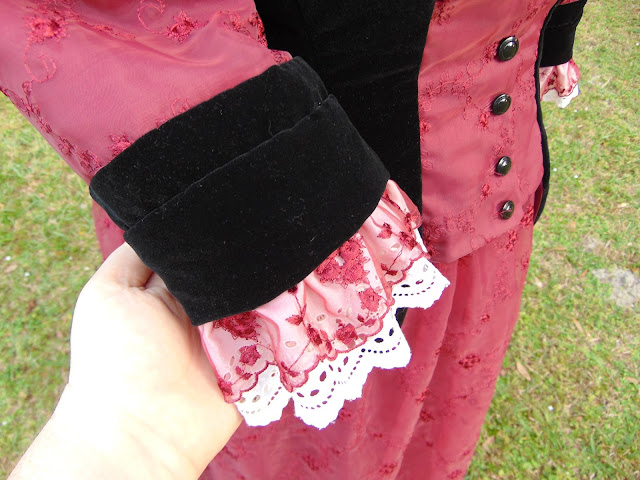Fabric: Black velvet (rayon/poly blend), embroidered organza (polyester), and burgundy broadcloth (cotton).
Chest: 44"
Waist: 34/35"
Hip: <55"
Hem: 41" at front
Sleeves are 3/4 length.
Why, why, WHY DOES IT LOOK MAGENTA?! I don't know what was up with my camera today, but it's seriously not magenta. It's like a burgundy red.
I have been holding on to this embroidered organza for years. I bought it back when I first started sewing and didn't know much/care much about the historical accuracy of fabrics. It's polyester, so...it is definitely not historically accurate for fiber content, but machine and hand embroidered silk and cotton organza fabrics were around, so I don't feel too bad. The only way I'm laying hands on embroidered silk organza is if I win the lottery or commit a felony. And since I look terrible in orange and don't like sharing a room, I'll stick with the cheaper polyester stuff. For now.
~The Bodice~
I combined and front and back sections from two different Truly Victorian patterns for this one. I used the front and vest pieces from the #405 vest basque, and the back, side-backs, and sides from #463 Vest Bodice. A little reshaping on the sides to make them meet at the hem, and that's all it took. I added the standing collar by my own drafting and recut the vest section to make the sweetheart dip less pronounced.
Because I decided to use a more dramatic figure for this one (44" chest to a 34" waist), it was best to bone the seams to help with that shaping and keep the velvet from puckering under the bust and on the waist. I used 3/8" heavy duty nylon zip ties for the boning. I used to use 1/4" flat spring steel, but over the years I've come to find that nylon works far better. Complaints that the plastic and nylon bones eventually "shape themselves to the body" never made sense to me, since that is precisely what whalebone used to do. And aren't we trying to mimic whalebone?
Above you see the inside of the unfinished bodice. I typically interface my bodices with appropriate left over fabrics from other projects. Waste not, wh- blah, blah... I have the bones already cut to size and in the the little channels I will use to stitch them to the seams on one side. I don't bother with bias tape anymore except for the curved seams on either side of the center back.
~The Skirt~
It was a little frustrating getting a straight, bordered fabric to conform to an essentially not straight garment, but I managed by flipping things and making all the shaping happen at the top, the waistband, rather than at the hem. It's basically the same way you make an 18th century petticoat, by altering the top rather than the hem. I have very little skill drawing on a computer, but hopefully this gives some idea.
Showing the scalloped hem on the finished skirt.
Pleating the overlap to the already assembled lining.
Placing overlap on waistband. I did it off kilter on the one edge so that more of the edge embroidery would show when assembled. Also, the pic below shows the best representation of the real color, not the darned "magenta" photos. Grrrr...
~Finished~
The eyelet I used for the cuffs is 100% cotton and vintage. Not sure how old (like almost everything I get from the antique mart), but the quality definitely places before our time.
























The burgundy looks magenta because your camera is metering off the black velvet. I had this same problem when taking photos of my dark green velvet gown - either the gown was the right color and everything else was blown out and weird, or the surrounding colors were fine and the green velvet looked bizarre. Cameras hate velvet. Lol :-)
ReplyDelete